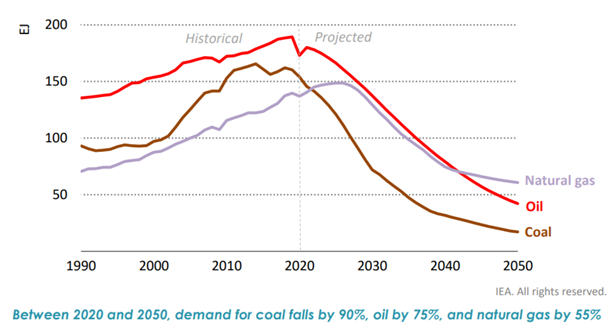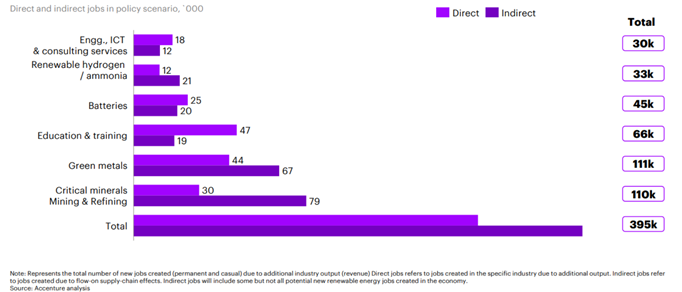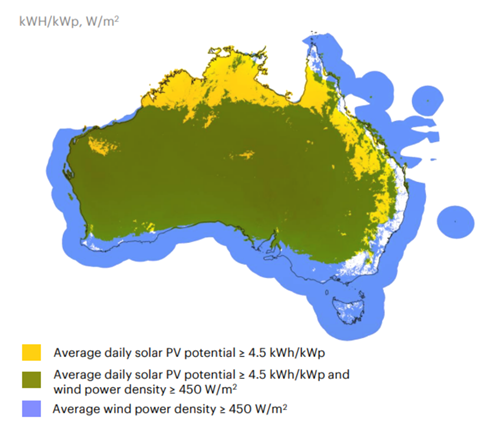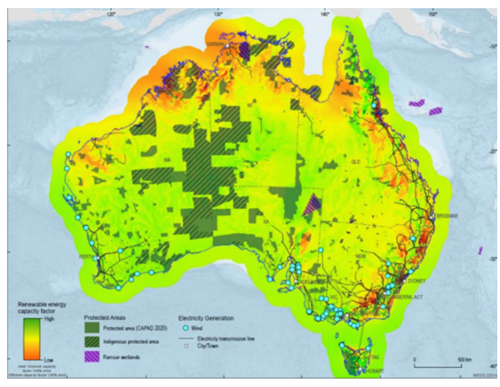Green energy superpower
As Australia undergoes its energy transition, there has been discussion around the country’s potential to establish itself as a ‘green energy superpower’ within a future global green economy. Illustrating this discussion is a recently released report by the Joint Standing Committee on Trade and Investment Growth. This report, which follows an inquiry which commenced in October of last year, draws together views from policymakers, businesses, and other interested parties on how trade and investment can facilitate Australia’s potential to become a renewable energy superpower in a global net-zero future. We take a closer look.
Background
In October last year, following a referral from the Minister for Trade Don Farrell, the Joint Standing Committee on Trade and Investment Growth was tasked with reporting on Australia’s transition to a green energy superpower and how this can be supported by trade and investment. At the time, the Committee Chair Mr Steve Georganas MP, Member for Adelaide noted: ‘The Committee wants to hear from Australian governments, businesses, and other interested parties from across the community about where trade and investment activities are already having a positive impact: emerging and possible future trends, areas of growth, and how these can be accelerated.’
In particular, the focus of the inquiry was to look specifically into areas that play to Australia’s strengths, including renewable energy, battery storage, energy supply and infrastructure, electric vehicle industry, infrastructure, advanced manufacturing, and services and technology.
Ultimately, the report hands down 16 recommendations for the Australian Government to consider, including;
- Leveraging Australia’s existing trade and investment architecture to maximise opportunities in global green economy;
- Supporting value-added manufacturing and export opportunities;
- Developing a national green energy superpower strategy;
- Aligning trade and investment promotion and awareness building functions with Australia’s green energy superpower ambitions; and
- Enhancing sovereign manufacturing capability in industries subject to supply constraints
Opportunities and challenges in a Net-Zero Future
The report serves to outline the domestic and global context driving Australia’s transition to a green energy superpower. Noting ‘global commitments to reduce greenhouse gas emissions and achieve net-zero emissions’, demand for Australia’s traditional emissions-intensive fossil fuels-based exports are set to decline as several of the country’s trading partners are set to decarbonise their economies and shift to more ‘green’ alternatives. Indeed, several submitters pointed to the International Energy Agency’s Net Zero by 2050 report, which, as the graph below shows, outlines that the global demand for coal could decline by 80 per cent and demand for gas by 50 per cent.
Figure 1: Coal, oil and natural gas production under the IEA’s Net-Zero Emissions Scenario

Source: International Energy Agency’s Net Zero by 2050 report (pg.101)
The report notes that in 2021, fossil fuels accounted for roughly 28 per cent of the total value of Australia’s exports. Of that, coal made up roughly 11 per cent and natural gas another 10 per cent. Considering this, many of the submissions the Committee received indicated that this high proportion of coal and gas within Australia’s export profile leaves the country ‘economically vulnerable in the face of the decarbonisation of its major trading partners’. Indeed, submitters like Boundless Earth pointed to the 2021 Sunshot report, which ‘estimates that 50% of Australia’s existing export value is exposed to risks from the energy transition. Likewise, DFAT told the Committee that if other countries ‘follow through on their commitments to net zero there is clearly going to be the risk that the markets for [coal and gas] will be diminished.’
The Committee does, however, note that other submissions argued that coal and natural gas would continue to play a role in the global energy mix ‘at least until greater firmed renewable energy capacity is deployed and new technologies are developed’ and possibly alongside ‘carbon capture and storage technology.’ The Committee likewise acknowledges that ‘while the direction of Australia’s major trading partners towards decarbonisation is clear, the timing and pathways remain uncertain.’
Nonetheless, while net-zero emissions commitments from major trading partners might pose a risk to Australia’s exports, the Committee report outlines that they likewise present a significant opportunity for Australia to both benefit economically and leverage its natural and comparative advantages to transition into a ‘green energy superpower.’ Submissions to the inquiry from DFAT, Austrade and Export Finance Australia all emphasised that ‘Australia stands to gain significant economic benefits from the world’s transition to net-zero’ while others argued that that the country was ‘well placed to thrive’. Indeed, multiple submitters to the Committee inquiry brought up the 2021 Sunshot report which claims that green energy export industries could add roughly $89 billion to the Australian economy while creating 395,000 jobs by 2040.
Figure 2: Jobs enabled by Australia’s clean energy export opportunities.

Source: Sunshot Clean Exports Research Report (pg.18)
Australia’s natural potential
These potential benefits are made possible due to Australia’s significant natural strengths and comparative advantages. For instance, as indicated by the graphics below, Australia’s natural geography provide abundant renewable energy resources with regards to both wind and solar.
Figure 3: High solar and wind power potential across Australia.

Source: Sunshot Clean Exports Research Report (pg.16)
Figure 4: Onshore and offshore wind capacity factor map with operating wind farms.

Source: Geoscience submission in ‘Australia's trade and investment opportunities in a global green economy’ Report (pg.18)
Indeed, the Committees report notes that ‘Australia has the highest solar radiation per square metre of any continent in the world,’ along with an ‘abundance of wind’.
Moreover, Australia is naturally endowed with a wealth of raw materials and critical mineral resources which are stated to be ‘essential inputs to the production of low emissions technologies.’ For instance, Geoscience Australia outlined to the Committee that; ‘Raw materials, including lithium, copper, nickel, silicon, manganese, graphite, rare earth elements and cobalt are the building blocks of clean energy technologies, such as batteries, electric vehicles (EVs), wind turbines and solar panels.’ Should Australia retain its market share of critical minerals, others such as the Grattan Institute predict that the market will be ‘worth double the present-day value of the coal market’ as demand increases over the next few decades.
Alongside these natural strengths are Australia’s well-developed comparative advantages. The report highlighted Australia’s reputation as a trusted and reliable trading partner, built upon strong environmental, social and governance standards that match ‘the highest global benchmarks’. Moreover, Australia has already well-established strengths in the mining and resources industry, as well as in research and development.
Path to a green-energy superpower
While these natural strengths and comparative advantages are noted by the Committee to ‘place Australia in a position of considerable advantage’, they argue these are ‘not sufficient on their own to ensure Australia benefits in a decarbonising global economy and Australia must actively pursue its ambition to become a green energy superpower.’ Indeed, the Committee notes that the vast range of opportunities for Australia are matched by the challenges, along with ‘complex range of factors, including economics (infrastructure, production, and transport costs), technological development, the strength of trade relationships, and the chosen decarbonisation pathways of trading partners.’
However, while many of the submitters to the inquiry outline measures the Federal Government can take to put Australia on the path to become a green-energy superpower, such as through tax credits and incentives, the report’s recommendations mainly push for further review and strategic planning. Indeed, one of the major recommendations is the call for Australia to develop an ‘overarching national green energy superpower strategy.’ Ultimately, industry and stakeholders locally and globally will watch with interest for the Albanese Government’s response to the report and any policies they may come up with to push Australia towards renewable superpower status.
Related Analysis
Certificate schemes – good for governments, but what about customers?
Retailer certificate schemes have been growing in popularity in recent years as a policy mechanism to help deliver the energy transition. The report puts forward some recommendations on how to improve the efficiency of these schemes. It also includes a deeper dive into the Victorian Energy Upgrades program and South Australian Retailer Energy Productivity Scheme.
2025 Election: A tale of two campaigns
The election has been called and the campaigning has started in earnest. With both major parties proposing a markedly different path to deliver the energy transition and to reach net zero, we take a look at what sits beneath the big headlines and analyse how the current Labor Government is tracking towards its targets, and how a potential future Coalition Government might deliver on their commitments.
The return of Trump: What does it mean for Australia’s 2035 target?
Donald Trump’s decisive election win has given him a mandate to enact sweeping policy changes, including in the energy sector, potentially altering the US’s energy landscape. His proposals, which include halting offshore wind projects, withdrawing the US from the Paris Climate Agreement and dismantling the Inflation Reduction Act (IRA), could have a knock-on effect across the globe, as countries try to navigate a path towards net zero. So, what are his policies, and what do they mean for Australia’s own emission reduction targets? We take a look.
Send an email with your question or comment, and include your name and a short message and we'll get back to you shortly.



